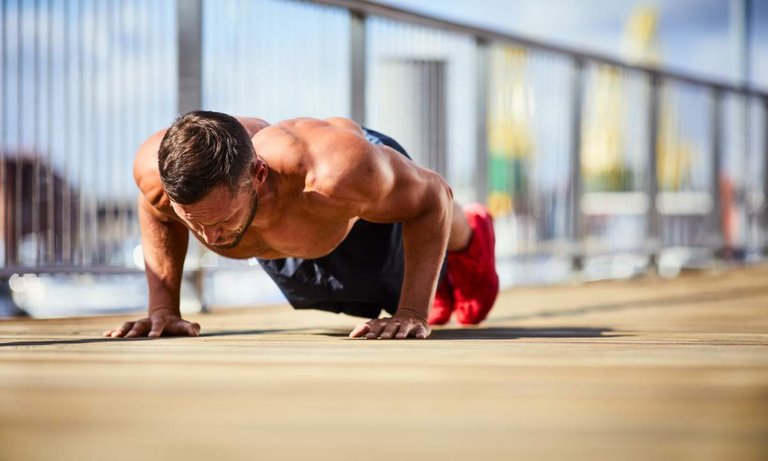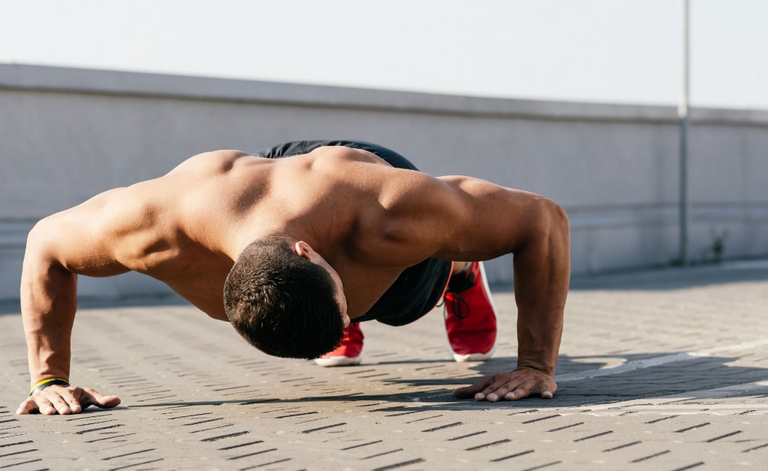Push-ups is a fairly simple exercise that allows you to use almost all muscle groups, so the benefits are clear. The exercise is done on the floor.

Depending on the type of push-up, you can work the muscles you need. You can focus on the muscles of the chest, arms, triceps, press or back, for example. The muscles of the abdomen and thighs also receive a static load. The push-ups have many variations. Among the most common and popular are the following:
classic push-ups from the floor
Emphasis lying down is taken with the support of socks (feet together or slightly at a distance from each other) and open palms. Putting your palms a little wider than your shoulders. The ideal performance is to touch the floor with the chest and chin, to look in front of you. Deltoid muscles, triceps, deltas are processed. After a few weeks, you can raise the level of difficulty.
push-ups with weights
Such push-ups are used by those who do power sports. Their focus is on the deep development of muscle tissue more than on the formation of relief. It is important to remember that weightlifting cannot be done instantly, ie to gain 10 kilos of extra weight on one of the days of the approach. Ideally, when increasing the load, use special vests in which you can change the weights (they are tailored so as to conveniently distribute the load on the body).
deep push-ups
This technique is designed to maximize the efficiency of muscle processing at high vertical amplitudes. To do this, lower the floor level (the bottom point when pressing).
slow push-ups
Its meaning is that endurance is trained without weight, and with extra weight - strength. The main thing in slow presses is continuity. This means that the lower and peak points of flexion of the arms do not need to stop, and immediately begin the reverse movement. The speed is different from standard push-ups, everyone chooses based on the fact that you should do 8-10 repetitions.
push-ups with a wide grip
A wide grip is used to emphasize the load on the pectoral muscles: the arms rest on the floor at a distance twice as wide as the shoulders, the elbows diverge when lowered. The burden of this exercise is by lifting the legs on a bench or stand. Raising the footrest 60 cm from the floor will increase the load to 75% of the athlete's weight. It is important to keep your back straight and prevent sagging abdomen, otherwise, the meaning of the press is completely lost.
push-ups with medium grip
This grip will help pump the triceps if performed correctly. The palms are located clearly at shoulder width, the elbows when lowering the torso move parallel to the body, pressing against it as much as possible. Weighting or simplification of the exercise is the same scheme as for the classic push-ups (adding weights, lifting the fulcrum of the legs or kneeling).
push-ups with a narrow grip
One of the most difficult variations of push-ups. The emphasis is on the palms (slightly extended outwards), which are located at a point in the middle of the chest. Legs shoulder-width apart or slightly wider. At the lower point, the sternum should touch the fingers. In this position, the exercise puts a maximum load on the triceps and the frontal deltoid muscle.
push-ups on one arm
Another challenging exercise designed for trained athletes. Those who are just starting to train it is better not to even try to do such a press, because there is a high probability of a broken supporting arm. In this case, a person will simply hit his face on the floor from a height of half a meter. Correct execution: the supporting arm is in line with the body, the other is behind the back; legs spread wide to ensure balance. At the lower point of the chest touches the floor, in reverse, the shoulders are kept parallel to the floor.
push-ups on the fingers
This emphasis strengthens the hand and all its joints. The type of squeezing in this case is not important (the exception is a narrow grip, as it is extremely difficult to place your fingers comfortably). In order to understand - whether it will be possible to do push-ups, you should stand a little in the starting position. If your fingers are tired and start to hurt in the first seconds, it is better to give up exercise and work with an expander to strengthen the hand.
Different variations of push-ups differ in the level of difficulty involved in muscle groups. Push-ups on one arm are considered one of the most difficult options. When performing them, alternate hands so that one of them does not lag behind the load from the other. The benefits of push-ups are obvious. This simple exercise helps to involve all muscle groups, ensuring the harmonious development of the body.
The benefits of push-ups
Push-ups are a great way to build a strong and beautiful muscular skeleton. The training unit is selected for any age and gender. Many people believe that this type of exercise trains only a small number of muscles, but when you shift the emphasis (support positions of the arms and legs), the whole body is involved in the work. Active pressure of your own body from the floor makes you work:
- large chest muscles
- triceps
- biceps
- deltoid muscles
- anterior dentate muscles (muscles of the lateral part of the chest and upper ribs)
In addition to forming and strengthening the muscular skeleton, push-ups, like any well-built exercise, develop proper breathing, lung function, improve blood flow to all parts of the body, strengthen ligaments and joints, saturate body tissues with oxygen. There is no age limit: even children under adult supervision can do push-ups.
Techniques of squeezing from the floor for muscle growth and relief formation:
strengthening the triceps
With a narrow position of the hands. The main thing is the correct technical execution: the palms are as close as possible (fingers lie on top of each other), at the lowest point of the amplitude of the lowering of the chest touches the hands, elbows apart.
Press the middle grip when the elbows move as close as possible to the body.
Complications or the transition to fists in the focus is added only after it becomes clear how well the triceps work.
obtaining high-quality relief
One point should be made at once - the relief will not form if there is a large amount of subcutaneous fat on the muscles. The picture will be formed only if the athlete has enough muscle mass.
Effective exercises will help to make the arms embossed if you perform them with a gradual consistent weighting. Otherwise, the muscles will get used to the weight and will only maintain their own condition (even increasing repetitions will not help).
Drawing abdominal muscles will help to form back push-ups. The correct technique is similar to bench press: the hands rest behind the bench or other elevation, the buttocks above the floor, the feet - on the heels as far as possible from the point of support of the palms; arms are bent to a position where the elbows form a right angle (more acute position requires good physical training).
weight gain
The first thing you need to learn if you want to gain weight - is that the technique is completely changing. Ordinary exercises weighing up to 80 kilos will not give any results. Important: a dense balanced diet for weight gain, a clear regularity of training, proper rest.
The classic push-up is used, which is performed very slowly with a forceful explosive ending. That is, the body descends slowly and smoothly to the lowest point of the amplitude (2-3 seconds), is fixed for a moment and a powerful forceful movement returns back. The ideal number is 8-12 to 4-5 approaches per set. The scheme of push-ups from the floor for muscle growth implies that you should gradually increase the repetition over 15 weeks.
How to do push-ups
The main mistake of all beginners is the contempt for the technique of execution. In the best case, the wrong position of the body will lead to a lack of clear results, even after many months of training. At worst - to muscle strain, tendon injuries, joints, accidents. Proper squeezing from the floor means:
- mandatory warm-up of the whole body before exercise, special attention is paid to the hands and shoulders
- correct placement of palms, feet, and neck (chin at chest level
it is recommended to use special wrist straps - with all types of push-ups, the back remains straight, the whole body forms a single straight line: neck, back, thighs, heels
- correct breathing: movement down is on the inhale, return to the straight arms - on the exhale
- regularity of training: one approach a month even for a hundred presses will not give any effect
- correct selection of load frequency: it makes no sense to work on wear in one approach when you can break the workout into several stages.

Features of exercise technique
The technique of push-ups is known to all, but when performing the exercise, you can take into account your goals. Yes, if your main task is to work the pectoral muscles, then do the exercise as follows:
- Accept the emphasis lying down, put your palms on the floor, a level slightly wider than your shoulders. Extend your legs down, rest your socks firmly on the floor. Keep your back straight, try to look a little forward.
- Go down at medium speed. At a lower point between the surface and the chest should be a distance of several centimeters. But you can also do push-ups before touching the floor with your chest if the mobility of your shoulder joints is sufficiently developed. This type of push-up is most often used in CrossFit.
- Straighten your arms, try to return to the starting position. Hold it for a second, then repeat the movement. To increase the load on the pectoral muscles, try to slightly straighten the elbows to the sides without pressing them to the body. Incomplete amplitude is recommended to work. Keep your chest muscles in constant tension and do not fully extend your elbows.
The pectoral muscles are also well worked during push-ups and head-down push-ups, in which the legs are placed on a surface 40-60 cm high. You can also use push-ups with your hands on the hills. The emphasis, in this case, is on the lower chest area. This option is easier for many novice athletes than classic push-ups, so you can use it to hone your technique.
If your task is to work the triceps, do push-ups as follows:
- Take the emphasis on lying down, place your hands longer than in the previous version, approximately at chest level. They should be parallel to each other.
- Start going down. The amplitude of the movements will be similar, but the elbows should be closer to the body.
- Straighten your arms, return to the starting position, and then repeat the movement. For extra load on the medial triceps head, try to work with limited amplitude. You do not need to go down completely, otherwise, the load will be transferred to the chest muscles. Also, for better triceps, try not to bend your elbows at the top.
Triceps push-ups on fists work well. You can also complicate any variation of push-ups by using extra weights. Usually, a disc from the bar on the back or a special weighting vest is used. But don't overdo it with weights, especially if you have spine problems.